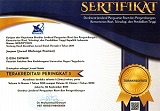Distribution practice method of badminton lob punch accuracy
DOI:
https://doi.org/10.21831/jorpres.v19i3.37054Keywords:
distribution method, lob, badmintonAbstract
The aim of this research is to determine the effect of the distribution practice method on the accuracy of lob shots in badminton. This study employs an experimental method, utilizing a One Group Pretest and Posttest design. The sample consists of 11 athletes. Data collection techniques involve tests and measurements, with the research instrument being a lob shot accuracy test. Data analysis is performed using the t-test formula at a significance level of 5%. The results of hypothesis testing indicate that there is an influence of the distribution practice method on the accuracy of badminton lob shots. Therefore, the conclusion is that there is an impact of the distribution practice method on the accuracy of lob shots in badminton. This demonstrates that the distribution practice training method is suitable for improving the accuracy of badminton lob shots
References
Ali, S. K. B. S., & Siong, N. U. (2023). Effectiveness of a comprehensive module in improving serving skills and lob shots during badminton training. Journal of Physical Education and Sport, 23(5). https://doi.org/10.7752/jpes.2023.05141.
Andreescu, M. (2023). The impact of the use of immunosuppressive treatment after an embryo transfer in increasing the rate of live birth. In Frontiers in Medicine (Vol. 10). https://doi.org/10.3389/fmed.2023.1167876.
Arduta, M. Z., Kusuma, I. J., & Festiawan, R. (2020). Faktor Penentu Minat Siswa SMP dalam Mengikuti Ekstrakurikuler Bulu Tangkis di Purwokerto. Multilateral Jurnal Pendidikan Jasmani Dan Olahraga. https://doi.org/10.20527/multilateral.v19i1.8322.
Bayuri, F., Syafaruddin, S., & Yusfi, H. (2022). Latihan drilling smash terhadap ketepatan smash bulu tangkis. Altius: Jurnal Ilmu Olahraga Dan Kesehatan, 11(2). https://doi.org/10.36706/altius.v11i2.18439.
Gleeson, M. (2007). Immune function in sport and exercise. In Journal of Applied Physiology. https://doi.org/10.1152/japplphysiol.00008.2007.
Ikhtiar, R., Adi, S., Widiawati, P., & Hariadi, I. (2023). Pengembangan Model Variasi Latihan Pukulan Backhand Overhead Lob Pada Atlet PB. Putra Pandaan Usia 15-18 Tahun. Sport Science and Health, 5(5). https://doi.org/10.17977/um062v5i52023p563-572.
Juliansyah, M. A. (2021). Pengaruh Latihan Shadow dan Power Otot Lengan terhadap Pukulan Overhead Lob Bulu Tangkis [Universitas Negeri Yogyakarta]. https://eprints.uny.ac.id/71344/1/fulltext_muhammad akbar juliansyah_19711251005.pdf.
Karyono, T. H., & Paluris, D. S. (2022). Pengaruh Latihan Basic Movement Berpindah Tempat Terhadap Kelincahan Atlet Bulu Tangkis. Jorpres (Jurnal Olahraga Prestasi), 18(1). https://doi.org/10.21831/jorpres.v18i1.48381.
Khan, K. M., Thompson, A. M., Blair, S. N., Sallis, J. F., Powell, K. E., Bull, F. C., & Bauman, A. E. (2012). Sport and exercise as contributors to the health of nations. The Lancet. https://doi.org/10.1016/S0140-6736(12)60865-4.
Lismadiana, L. (2021). Manajemen pembinaan atlet berbakat (PAB) cabang olahraga bulutangkis Daerah Istimewa Yogyakarta. Jorpres (Jurnal Olahraga Prestasi), 17(2). https://doi.org/10.21831/jorpres.v17i2.43236.
Lu, L., & Wei, W. (2023). Influence of Public Sports Services on Residents' Mental Health at Communities Level: New Insights from China. International Journal of Environmental Research and Public Health, 20(2). https://doi.org/10.3390/ijerph20021143.
Muchhamad Sholeh, & Andibowo, T. (2022). Perbedaan Pengaruh Latihan Drill dan Pola Pukulan Terhadap Keterampilan Lob Bulu Tangkis pada Siswa Extrakurikuler Bulu Tangkis. Jurnal Ilmiah Spirit, 22(1). https://doi.org/10.36728/jis.v22i1.1823.
Phomsoupha, M., & Laffaye, G. (2015). The Science of Badminton: Game Characteristics, Anthropometry, Physiology, Visual Fitness and Biomechanics. In Sports Medicine. https://doi.org/10.1007/s40279-014-0287-2.
Rojas-Valverde, D., Bonilla, D. A., Gómez-Miranda, L. M., Calleja-Núñez, J. J., Arias, N., & Martínez-Guardado, I. (2023). Examining the Interaction between Exercise, Gut Microbiota, and Neurodegeneration: Future Research Directions. In Biomedicines (Vol. 11, Issue 8). https://doi.org/10.3390/biomedicines11082267.
Rubinstein, M. R., Burgueño, A. L., Quiroga, S., Wald, M. R., & Genaro, A. M. (2023). Current Understanding of the Roles of Gut–Brain Axis in the Cognitive Deficits Caused by Perinatal Stress Exposure. In Cells (Vol. 12, Issue 13). https://doi.org/10.3390/cells12131735.
Susanto, H. (2009, July). Masih Tinggi, Minat Masyarakat pada Bulutangkis. Detik Sport. https://sport.detik.com/raket/d-1174658/masih-tinggi-minat-masyarakat-pada-bulutangkis.
Vasconcelos Lima Diniz, L. (2023). Sports nutrology and gut microbiota. International Journal of Nutrology, 16(1). https://doi.org/10.54448/ijn23109.
Wibowo, V., Putra, I. M., & Saleh, K. (2022). Pengaruh Latihan Skipping dan Push Up Terhadap Ketepatan smash Bulu Tangkis di PB TJ Prestasi. SPORT-Mu: Jurnal Pendidikan Olahraga, 3(2). https://doi.org/10.32528/sport-mu.v3i2.9013.
Yogaswara, A., Dhuha, A. A., Kresnapati, P., & Wardani, R. S. K. (2023). Analisis Latihan Dumbbell Wrist Terhadap Backhand Overhead Lob Pemain Bulutangkis. Jendela Olahraga, 8(2). https://doi.org/10.26877/jo.v8i2.14216
Downloads
Published
How to Cite
Issue
Section
License
Authors who publish with this journal agree to the following terms:
- Authors retain copyright and grant the journal right of first publication with the work simultaneously licensed under a Creative Commons Attribution License that allows others to share the work with an acknowledgement of the work's authorship and initial publication in this journal.
- Authors are able to enter into separate, additional contractual arrangements for the non-exclusive distribution of the journal's published version of the work (e.g., post it to an institutional repository or publish it in a book), with an acknowledgement of its initial publication in this journal.
- Authors are permitted and encouraged to post their work online (e.g., in institutional repositories or on their website) prior to and during the submission process, as it can lead to productive exchanges, as well as earlier and greater citation of published work (See The Effect of Open Access).




